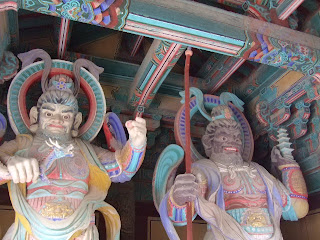These sorts of structures are very common around Buddhist temples.
They represent the different levels of life, from earth to heaven.
Prayer tiles are another common sight. It was strange to see tiles written in so many languages!
This is Anapji Pond, one of the most beautiful places I've ever had the fortune to see. The pictures don't do it justice. It was so breathtaking in the fall that I'm anxious to come back in the spring.
The next stop on our tour was Bulguksa Temple, another UNESCO world heritage site. Many Koreans believe it's the most beautiful temple in the country. It's certainly the largest I've ever seen and one of the most well-preserved. I've been told that the art of making the green paint seen on so many Korean temples was actually lost with time, so most of them have been repainted with as close to the shade as can be found. But Bulguksa looked as though the paint had been allowed to fade, which added to the feeling that this building had really stood the test of time. It was built in the 8th century, which makes its huge size even more impressive.
This particular pagoda, Dabotap, is much more ornate than traditional stone pagodas. Its name means "the pagoda of many treasures."
Every Buddhist temple is equipped with several instruments meant to represent the different elements. The fish seen here represents the wind.
To go with the largest temple I've ever seen, this was the largest pile of rock towers I've ever seen. They were everywhere in this courtyard, including the the inside walls and the doorways.
Although no temple is complete without a bell, this particular beauty is stored at the National Museum. It's the largest existing bell in Korea, made entirely of bronze. My guidebook says that, on a clear day, it can be heard from over 40 miles away when struck! Although its technical title is the Bell of King Seongdeok, it's also known as the Emille Bell due to a legend about its creation. Supposedly, the bell had to be recast several times because it wouldn't make a sound. Then a monk from the village dreamed about the solution to the problem: allowing a child to cast the mold. This was done, and the final casting was successful.
We ended our day at the royal tombs, where members of the Silla royal family were buried under huge mounds of earth. You can just see a little person standing in front of the tomb farthest to the left, which should give you some idea of the massive size of these tombs. The largest were for the kings buried here. There had to be at least a dozen of them, of varying sizes, in this vast park.
This area also houses the Cheomseongdae Observatory, the oldest existing one in the Far East.
It was built in 634! Hence why tourists are no longer allowed inside.
The weekend was a blur! I have one more conference to look forward to, and it's actually going to be in Jeju, where I live. I'm looking forward to sharing my city with all my Fulbright friends, but I really hope I can come back to Gyeongju again. Among other things, there's a tap dancing museum in this city with shoes from as far back as the 6th century! It's no kimchi museum, but my interest is piqued.




















No comments:
Post a Comment